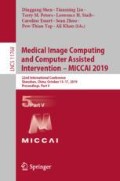Abstract
Accurate manual execution of a pre- or intraoperatively generated plan is an essential ability of surgeons and can be related to a successful outcome of a surgery. Therefore, surgeons regularly need to control multiple parameters simultaneously which increases control complexity, particularly if the information has to be derived and fused from multiple reference frames (e.g. displays). In master-slave or cooperative robotic settings haptic assistances can be provided to facilitate manual control of e.g. milling tasks. Haptic assistances present the information in the human hand reference frame and therefore can make mental transformation obsolete. Additionally, in contrast to autonomous robotic milling, the surgeon remains in the control loop and is able to customize the plan according to his expertise and intraoperative requirements. This paper experimentally investigates effects on usability of different haptic assistances in separate degrees of freedom during a multiple parameter control task. Subjects had to apply a force and follow a path with a constant velocity, while different levels of haptic assistance were provided. Results indicate that each assistance provides a statistically significant improvement with respect to the associated measure (i.e. force, position, velocity) and the task-associated perceived workload is reduced. Consequently, haptically assisted milling allows for an efficient control of milling parameters during surgery whose performance lies in between completely manual and autonomous robotic execution while keeping the surgeon in the control loop.
Access this chapter
Tax calculation will be finalised at checkout
Purchases are for personal use only
References
Troccaz, J., Peshkin, M., Davies, B.: Guiding systems for computer-assisted surgery: introducing synergistic devices and discussing the different approaches. Med. Image Anal. 2, 101–119 (1998)
Radermacher, K.: Computerunterstützte Operationsplanung und-ausführung mittels individueller Bearbeitungsschablonen in der Orthopädie. Shaker (1999)
Luczak, H.: Prinzipien menschlicher Informationsverarbeitung-Analytik und Gestaltung informatorisch-mentaler Arbeit. In: Luczak, H. (ed.) Arbeitswissenschaft, pp. 126–213. Springer, Heidelberg (1993). https://doi.org/10.1007/978-3-662-21634-7_7
Wickens, C.D., Hollands, J.G., Banbury, S., Parasuraman, R.: Engineering Psychology and Human Performance. Pearson, London (2013)
Schleer, P., Drobinsky, S., Radermacher, K.: Evaluation of different modes of haptic guidance for robotic surgery. IFAC-PapersOnLine 51, 97–103 (2019). https://doi.org/10.1016/j.ifacol.2019.01.035
Cunha-Cruz, V., et al.: Robot-and computer-assisted craniotomy (CRANIO): from active systems to synergistic man—machine interaction. Proc. Inst. Mech. Eng. Part H: J. Eng. Med. 224, 441–452 (2010)
Denis, K., et al.: Influence of bone milling parameters on the temperature rise, milling forces and surface flatness in view of robot-assisted total knee arthroplasty. In: International Congress Series, pp. 300–306. Elsevier (2001)
Engelhardt, M., Bast, P., Lauer, W., Rohde, V., Schmieder, K., Radermacher, K.: Manual vs. robotic milling parameters for development of a new robotic system in cranial surgery. In: International Congress Series, pp. 533–538. Elsevier (2004)
Fu, Y., Yin, H., Pan, B.: Fuzzy based velocity constraints of virtual fixtures in tele-robotic surgery. In: 2014 IEEE International Conference on Robotics and Biomimetics (ROBIO), pp. 2625–2630. IEEE (2014)
Kouskoulas, Y., Renshaw, D., Platzer, A., Kazanzides, P.: Certifying the safe design of a virtual fixture control algorithm for a surgical robot. In: Proceedings of the 16th International Conference on Hybrid Systems: Computation and Control, pp. 263–272. ACM (2013)
Pezzementi, Z.A., Okamura, A.M., Hager, G.D.: Dynamic guidance with pseudoadmittance virtual fixtures. In: ICRA, pp. 1761–1767 (2007)
Bowyer, S.A., Davies, B.L., Rodriguez, Y., Baena, F.: Active constraints/virtual fixtures: a survey. IEEE Trans. Robot. 30, 138–157 (2014). https://doi.org/10.1109/tro.2013.2283410
Franke, T., Attig, C., Wessel, D.: A personal resource for technology interaction: development and validation of the Affinity for Technology Interaction (ATI) scale. Int. J. Hum.–Comput. Interact. 35(6), 456–467 (2018)
Enayati, N., De Momi, E., Ferrigno, G.: Haptics in robot-assisted surgery: challenges and benefits. IEEE Rev. Biomed. Eng. 9, 49–65 (2016)
Allin, S., Matsuoka, Y., Klatzky, R.: Measuring just noticeable differences for haptic force feedback: implications for rehabilitation. In: Proceedings of the 10th Symposium on Haptic Interfaces for Virtual Environment and Teleoperator Systems, HAPTICS 2002, pp. 299–302. IEEE (2002)
Peon, A.R., Prattichizzo, D.: Reaction times to constraint violation in haptics: comparing vibration, visual and audio stimuli. In: World Haptics Conference (WHC), pp. 657–661. IEEE (2013)
Bast, P., Engelhardt, M., Lauer, W., Schmieder, K., Rohde, V., Radermacher, K.: Identification of milling parameters for manual cutting of bicortical bone structures. Comput. Aided Surg. 8, 257–263 (2003)
Abbink, D.A., Mulder, M., Boer, E.R.: Haptic shared control: smoothly shifting control authority? Cogn. Technol. Work 14, 19–28 (2012)
Author information
Authors and Affiliations
Corresponding author
Editor information
Editors and Affiliations
Rights and permissions
Copyright information
© 2019 Springer Nature Switzerland AG
About this paper
Cite this paper
Schleer, P., Drobinsky, S., Hmaid, T., Radermacher, K. (2019). Haptic Modes for Multiparameter Control in Robotic Surgery. In: Shen, D., et al. Medical Image Computing and Computer Assisted Intervention – MICCAI 2019. MICCAI 2019. Lecture Notes in Computer Science(), vol 11768. Springer, Cham. https://doi.org/10.1007/978-3-030-32254-0_20
Download citation
DOI: https://doi.org/10.1007/978-3-030-32254-0_20
Published:
Publisher Name: Springer, Cham
Print ISBN: 978-3-030-32253-3
Online ISBN: 978-3-030-32254-0
eBook Packages: Computer ScienceComputer Science (R0)


